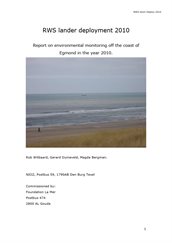Witbaard et al. 2011. Report on continuous environmental monitoring off the coast of Egmond in the year 2010.
In the research area the average Ensis density is 265 individuals / m². There are three cohorts in the area present. They have approximate sizes of 50, 80 and 120 mm. Highest densities appear to be found close to the coast. Further offshore densities decrease, but average size is larger. Shell growth takes place between the end of April and mid September. Condition index probably peaks in May and June. The data collected in the near coastal environment of Egmond shows a marked seasonal variation in the ratio between Chlorophyll and Silt. There are also marked tidal effects on the quality, quantity and distribution of Silt and Chlorophyll above the bottom. Highest concentrations are found closest to the seafloor and strongly dependent on tidal currents. During the measurement periods in autumn 2010 two events have been observed at which concentrations of mud surpass 2500 mg/L. The associated increase in the chlorophyll concentrations suggest that organic material is RWS short Deploy 2010 51 either attached to this sedimentary material or that chlorophyll rich particles respond in a similar way as inorganic particles. In any case this resuspended chlorophyll rich material can potentially act as food source for filter feeders. The analyses of obtained field data suggest that valve gape decreases when mud concentrations surpass concentrations of about 400 mg/l. The consequence of this decrease on assimilation and growth remains unknown.

